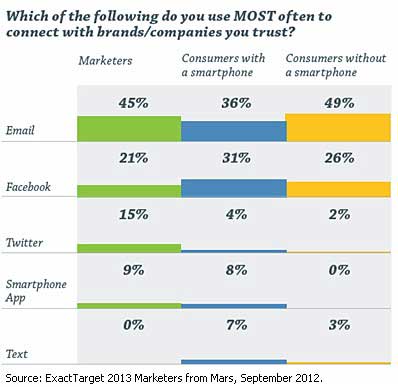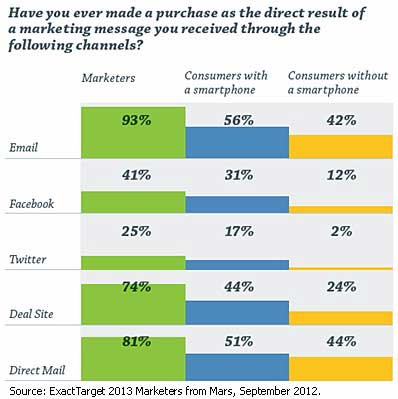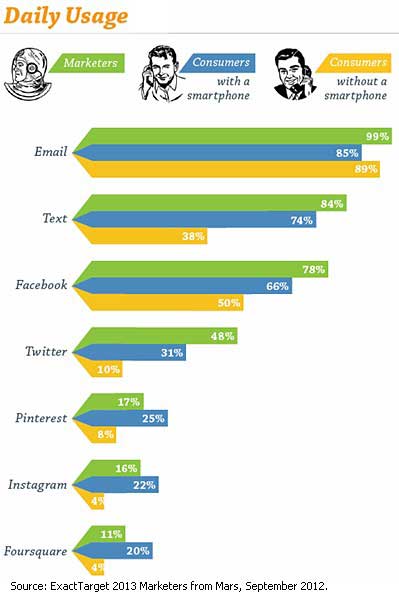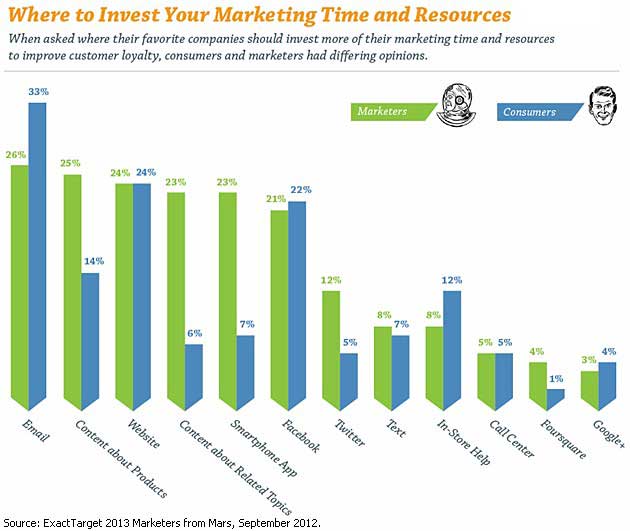Marketers are not typical consumers: They're more likely than other online consumers to explore new digital environments, own a smartphone, and use various digital media frequently. Consequently, marketers can lose touch with the people they're trying to reach, according to a study by ExactTarget.
Below, additional findings from ExactTarget's new "Subscribers, Fans, and Followers" study titled "Marketers From Mars," which polled online consumers and marketers about their use of digital media.
Basic Online Behaviors
In its report, ExactTarget defines three segments of digital users in the US:
- Subscribers: Online consumers who receive at least one permission-based email a day.
- Fans: Online consumers with an active Facebook account who have become a fan (i.e., "liked") at least one company or brand on Facebook.
- Followers: Online consumers with an active Twitter profile who "follow" at least one company or brand on Twitter.
Marketers are over-represented in all three digital user segments. However, that finding is most pronounced in the Followers segment, where marketers are overrepresented by a 5:1 ratio:
- Subscribers: 98% of marketers are email subscribers, compared with 93% of online consumers.
- Fans: 86% of marketers are Facebook fans, compared with 58% of online consumers.
- Followers: 61% of marketers are Twitter Followers, compared with 12% of online consumers.
Similarly, 90% of marketers own a smartphone, compared with only 51% of online consumers.
Not surprisingly, those 51% of smartphone-owning consumers tend to behave more like marketers than consumers without smartphones. They are more likely than consumers without smartphones to use technologies such as email, mobile apps, and social media. Also, smartphone-owning consumers tend to share more content and purchase more products online than consumers who don't own smartphones.
Digital Behaviors by Channel
Marketers differ from consumers in the way they use key digital channels: Email, Facebook, and Twitter.
Email:
- 45% of marketers prefer to interact with brands via email, compared with 36% of online consumers with a smartphone, and 49% of online consumers who do not own a smartphone.
- 93% of marketers have made a purchase as a direct result of an email marketing message, compared with 49% of online consumers.
- Marketers (34%) are less likely than online consumers (46%) to check email at the end of the day.
Facebook:
- 21% of marketers prefer to interact with brands via Facebook, compared with 31% of online consumers with a smartphone and 26% of online consumers who do not own a smartphone.
- 41% of marketers report having made a purchase as the result of a message they saw on the site, compared with 21% of online consumers.
- Facebook is the preferred means of sharing with family and friends for 59% of marketers, vs. 34% of online consumers.
Twitter:
- Among those using Twitter, 58% of marketers follow brands to receive advanced notice about new products, compared with 46% of Twitter-using consumers who do so.
- 25% of marketers reporting making a purchase as a result of a message via Twitter, compared with 9% of online consumers.
Interacting With Brands Online
Online consumers with a smartphone rely on Facebook (31%) nearly as much as email (36%) for interacting with brands they trust, whereas consumers without a smartphone are far more likely to rely on email (49%) than Facebook (26%) for brand communications:

Factors That Influence Purchasing Decisions
Among both consumers with a smartphone and marketers, email still has the greatest influence on purchasing decisions (93% and 56%, respectively), whereas among consumers without smartphones, direct-mail messages (44%) are most influential in the purchasing process. Even so, email is the second-most influential channel among that segment (42%).

Deal sites and direct mail also tend to sway marketers (74% and 81%, respectively) and consumers with smartphones (44% and 51%, respectively) when making purchasing decisions.
Daily Use of Social Channels
Regarding daily social media use, some interesting trends and differences emerge between marketers and consumers.
Marketers surpass consumers in their daily use of email, texting, Facebook, and Twitter. in addition, consumers who own a smartphone are more likely than those without a smartphone to use Facebook (66% vs. 50%) and Twitter (31% vs. 10%) on a daily basis.

Interestingly, consumers with smartphones are using emerging platforms such as Pinterest, Instagram, and Foursquare at higher rates than marketers.
Marketing Spend
Marketers have strong opinions about where their time and resources should be invested, and consumers do, too.
Not surprisingly, marketers tend to place a higher emphasis on emerging channels than consumers:
- Value of an app: 23% of marketers say they perceive value in smartphone apps for building customer loyalty, compared with 7% of online consumers who say the same.
- Email: 33% of consumers say companies should invest more marketing dollars in email, compared with 26% of marketers who say the same.
- Twitter: 5% of consumers say companies should invest more marketing dollars in Twitter, compared with 12% of marketers who say the same.

Consumers express little interest in general content, whether about products (14%) or related topics (6%); they're more enthusiastic about Facebook content (22%) and brand websites (24%).
Marketers and consumers do see eye-to-eye in several areas:
- Digital morning habits: Both marketers (76%) and consumers (69%) favor email as their first online "check" of the day.
- Appreciating a good deal: Both marketers (74%) and consumers (73%) subscribe to receive email coupons and discounts.
- Digital socializing: Both marketers (81%) and consumers (66%) use Facebook to stay on top of their social lives.
About the data: Findings are based on a survey of 1,201 consumers and 411 marketers conducted in September 2012. Consumer responses were weighted by age and gender according to the 2010 US Census Bureau population estimates and Pew Internet Project's online activity data to reflect the online US consumer population. Marketer responses were not weighted. Among the marketers, 62 respondents were recruited via Twitter, and 349 respondents were recruited from marketing-specific email lists.




